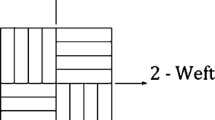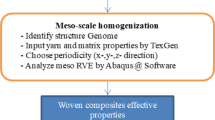For several years, kites have been representing an innovative technology in the maritime sector to reduce the fuel consumption through an auxiliary propulsion or producing energy onboard. Regarding the continuous increase in kite sizes, one of the main objectives is to determine whether a leading-edge inflatable kite and its components will be able to withstand the pressure field induced by the aerodynamic load. Therefore, an accurate identification of stress fields in them is required by designers. For this aim, a fluid-structure interaction method was developed by coupling a 3D nonlinear lifting-line model with the Abaqus™ 2017 finite-element software tools. Within this framework, a structural analysis was performed for a kite made of a woven fabric by employing the thin-layer finite-element technique for its weak bending properties. This modeling method is new and is not available in the Abaqus™.











Similar content being viewed by others
References
V. Podeur, D. Merdrignac, M. Behrel, K. Roncin, C. Fonti, C. Jochum, Y. Parlier, and P. Renaud, “Fuel economy assessment tool for auxiliary kite propulsion of merchant ship,” Houille Blanche, No. 1, 5-7, (2018).
C. Duport, J.-B. Leroux, K. Roncin, C. Jochum, and Y. Parlier, “Benchmarking of a 3D nonlinear lifting-line method against 3D RANSE simulations,” La Houille Blanche, 105, Nos. 5-6, 70-73 (2019).
C. Duport, “Modeling with consideration of the fluid-structure interaction of the behaviour under load of a kite for auxiliary traction of ships,” Ph.D. thesis (2018).
A. Maison, A. Nême, and J.-B. Leroux, “De la problématique du dimensionnement de grands kites,” ATMA, No. 2717 (2017).
G. Dadd, D. Hudson, and R. Shenoi, «Determination of kite forces using three-dimensionnal flight trajectories for ship propulsion,» Renew. Energy, 36, No. 10, 2667-2678, (2011).
J. Breukels, R. Schmehl, and W. Ockels, “Aeroelastic simulation of flexible membrane wings based on multibody system dynamics in airborne wind energy,” in: Airborne Wind Energy, series Green Energy and Technology. Eds. U. Ahrens, M. Diehl, and R. Schehl, Springer, 287-305, (2013).
A. Bosch, R. Schmehl, P. Tiso, and D. Rixen, “Dynamic nonlinear aerolastic model of a kite for power generation,” J. Guid. Control. Dyn., 37, No. 5, 1426-1436 (2014).
J. van Til, M. De Lellis, R. Saraiva, and A. Trofino, “Dynamic model of a c-shaped bridled kite using a few rigid plates, Ch. 5 in: Airborne Wind Energy, series Green Energy and Technology Eds. R. Schmehl, Springer Nature Singapore Pte Ltd, 99-115 (2018).
R. van der Vlugt, A. Bley, M. Noom, and R. Schmehl, “Quasi-steady model of a pumping kite power system,” Renewable Energy, 131, 83-99, (2019).
J. C. M. Breuer and R. H. Luchsinger, “Inflatable kites using the concept of Tensairity,” Aerospace Sci. and Technol., 14, No. 8, 557-563, (2010).
A. Bosch, R. Schmehl, P. Tiso, and D. Rixen, “Nonlinear aeroelasticity, flight dynamics and control of a flexible membrane traction kite,” in: Airborne Wind Energy, Springer, 307-323, (2014).
A. Dixit and Harlal Singh Mali, “Modeling techniques for predicting the mechanical properties of woven-fabric textile composites: a review,” Mech. Compos. Mater. 49, No. 1, 1-20, (2013).
V. Kobelev and A. D. Larichev, “Model of thin-walled anisotropic rods,” Mech. Compos. Mater. 24, No. 1, 97-104, (1988).
J. Sacher, J. B. Leroux, A. Neme, and C. Jochum, “A fast and robust approach to compute nonlinear fluid-structure interactions on yacht sails - Application to a semi-rigid composite mainsail,” Ocean Eng., 201, 1-15, (2020).
K. Lu, M. Accorsi and J. Leonard, “Finite element analysis of membrane wrinkling,” Int. J. Numer, Meth. Eng., 50, 1017-1038, (2001).
E. Oñate, F. G. Flores, and J. Marcipar, “Membrane structures formed by low pressure inflatable tubes. new analysis methods and recent constructions,” in: Textile Composites and Inflatable Structures II, Eds. E. Oñate and B. Kröplin, Springer, 163-196, (2008).
D. Trimarchi, M. Vidrascu, D. Taunton, S. R. Turnock, and D. Chapelle, “ Wrinkle development analysis in thin sail-like structures using MITC shell finite elements,” Finite Elem. Anal. Des., 64, 48-64 (2013).
T. Belytschko, W. K. Liu, B. Moran, and K. Elkhodary, Nonlinear Finite Elements for Continua and Structures, John Wiley and Sons, (2013).
Stephen W. Tsai, Composites Design, Think Composites, (1988).
M. H. Sadd, Elasticity, Theory, Applications and Numerics, Elsevier (2005).
G. R. Cowper, “The shear coefficient in Timoshenko’s beam theory,” J. Appl. Mech., 33, 335-340 (1966).
M. Behrel, “Investigation of kites for auxiliary ship propulsion: experiment setup, trials, data analysis and kite specs novel identification approach,” Ph.D. thesis, Université de Bretagne Occidentale (2017).
Author information
Authors and Affiliations
Corresponding author
Additional information
Russian translation published in Mekhanika Kompozitnykh Materialov, Vol. 58, No. 6, pp. 1239-1262, November-December, 2022. Russian DOI: https://doi.org/10.22364/mkm.58.6.09.
Rights and permissions
Springer Nature or its licensor (e.g. a society or other partner) holds exclusive rights to this article under a publishing agreement with the author(s) or other rightsholder(s); author self-archiving of the accepted manuscript version of this article is solely governed by the terms of such publishing agreement and applicable law.
About this article
Cite this article
Desenclos, K., Nême, A., Leroux, J.B. et al. A Novel Composite Modeling Method to Analyze the Woven Fabric Structures of Leading-Edge Inflatable Kites. Mech Compos Mater 58, 867–882 (2023). https://doi.org/10.1007/s11029-023-10075-0
Received:
Revised:
Published:
Issue Date:
DOI: https://doi.org/10.1007/s11029-023-10075-0




